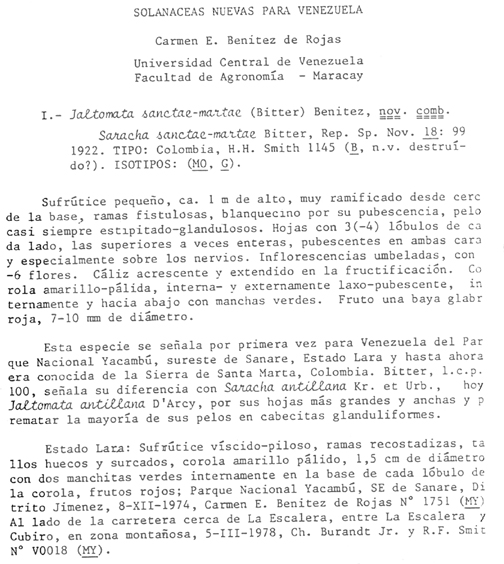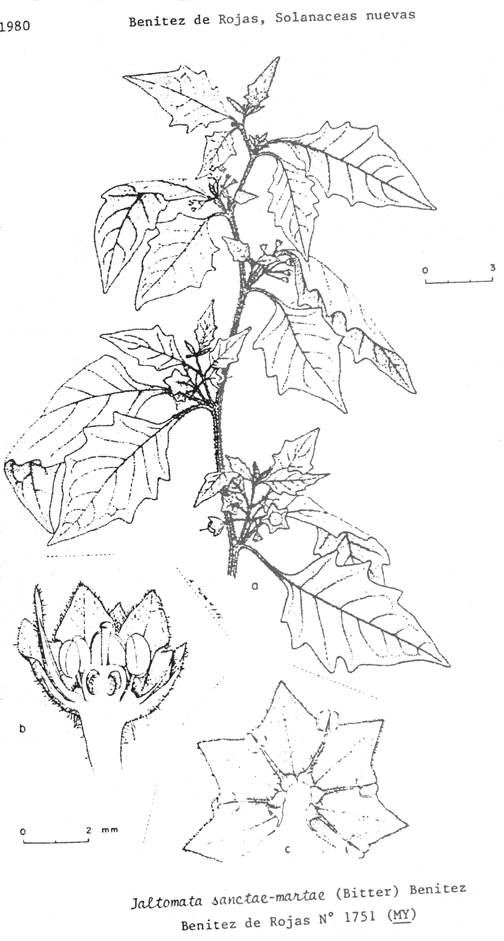

Jaltomata sanctae-martae (Bitter) Benítez |
revised 8 Oct 2015 |
Link to Jaltomata home page |
The information on this page may be cited as a communication with professor Thomas Mione, Central Connecticut State University, Biology Department, Copernicus Hall, 1615 Stanley Street, New Britain, Connecticut 06050-4010, United States of America. |
The following article by Carmen Benítez de Rojas appeared in Phytologia 47: 14 - 15. 1980.


| Country | region | Locality | elevation m | habitat | date | collector | data entry |
|---|---|---|---|---|---|---|---|
| Colombia | Santa Marta | no data |
1372 |
no data |
1898-1901 | H. H. Smith 1145 (K) TYPE | March 2009 |
| Colombia | Santa Marta | no data |
1829 |
no data |
1898-1899 | H. H. Smith 1855 (K) | March 2009 |
| Colombia | Magdalena | Sierra de Perijá, eastern Manaure, from Floridablanca to El Cinco | 2600 |
no data |
13 Nov 1959 | J. Cuatrecasas & R. Romero Castaneda 25282 (US) | Aug 2010 |
| Venezuela | Lara, Dto. Jimenez | Parque Nacional de Yacambú, sureste de Sanare | 1500 |
no data |
8 Dec 1974 | C. E. Benitez de Rojas 1751(US) | Aug 2010 |
| "Conocida de la Sierra Nevada de Santa Marta en Colombia, y en Venezuela en los estados Lara y Trujillo, creciendo en selvas nubladas a orillas de riachuelos, a elevaciones entre 800 y 2,100 m." (Benítez de Rojas 2010) |
:
Description:
| Figure | ||
Habit & Height |
"herb to 1 m" (Cuatrecasas 25282) | |
Branches, young |
||
Older |
||
| Leaves Size | ||
| Shape | ||
| arrangement and hairs | ||
| petiole | ||
Inflorescence |
to 10-flowered on type | Figure 2 |
Peduncle |
||
Pedicel |
||
| Calyx at flowering | ||
| at fruit maturity | ||
Corolla lobes/lobules |
||
shape and size |
||
color |
"cream-white" (Cuatrecasas 25282) | |
hairs |
||
radial corolla thickenings |
||
| Stamen length | ||
| filaments | ||
| anther length & color | "stamens yellow" (Cuatrecasas 25282) | |
| anthers of a flower dehisce simultaneously? | ||
| pollen grains | no data |
|
Stigma |
||
Style length |
||
Disk around ovary |
||
Ovules per ovary |
no data |
|
| Nectar | no data |
|
| Herkogamy | no data |
|
| Protogyny | no data |
|
| Fruit color (at maturity) and size | ||
| Infructescence | ||
| Seeds per fruit | ||
| Seed Size | ||
| Chromosome number | no data |
|
| Growability in Connecticut, USA | no data |
|
| How long does it take from flower to ripe fruit? | no data |
|
| Self-Compatible? | no data |
|
| Seed Germination | no data |
Variation among specimens: There are at least 10 flowers per inflorescence on the type and leaves are toothed (figure 2), and only 2 to 3 flowers per inflorescence on Smith 1855 (figure 3) and leaves are entire, collected from the same region. The specimen from Colombia's department Magdalena (Cuatrecasas 25282) has up to six flowers per inflorescence; this specimen has long hairs, densely hairy, and the hairs carefully viewed with a dissecting scope mostly not gland-tipped. |
|---|
| Figure 2. Type specimen. At least some of the hairs are gland-tipped, perhaps all were when the plant was alive and only some now show it? Colombia's primary political regions are departments, but H. H. Smith did not specify which department(s) he was in when he made the two collections listed in the table above. The Sierra Nevada de Santa Marta is in three departments. |
| Figure 3. H. H. Smith 1855 (K), branches densely villous with finger hairs. Difficult to determine if they are gland-tipped, looks like yes. |
Jaltomata auriculata and J. nitida also have white flowers and red (not orange) fruits. Jaltomata antillana has white flowers and red fruits as well but is unknown from the Andes.
Link to
key to the Jaltomata of Colombia and Venezuela.